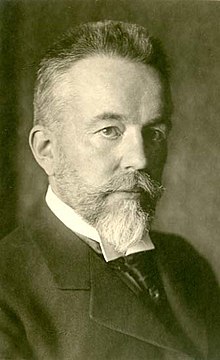Aurel Stodola
| Aurel Stodola | |
|---|---|

Aurel Stodola
|
|
| Born |
10 May 1859 Liptovský Mikuláš, Kingdom of Hungary (today: Liptovský Mikuláš, Slovakia) |
| Died | 25 December 1942 (aged 83) Zürich, Switzerland |
| Resting place | Liptovský Mikuláš, Slovakia |
| Residence | Hungary, Czechoslovakia, Switzerland |
| Education | Budapest University of Technology and Economics |
| Known for |
|
| Awards |
|
Aurel Boleslav Stodola (10 May 1859, Liptovský Mikuláš, Slovakia – 25 December 1942 Zürich, Switzerland) was a Slovak engineer, physicist, and inventor. He was a pioneer in the area of technical thermodynamics and its applications and published his book Die Dampfturbine (the steam turbine) in 1903. In addition to the thermodynamic issues involved in turbine design the book discussed aspects of fluid flow, vibration, stress analysis of plates, shells and rotating discs and stress concentrations at holes and fillets. Stodola was a professor of mechanical engineering at the Swiss Polytechnical Institute (now ETH) in Zurich. One of his students was Albert Einstein. In 1892, Stodola founded the Laboratory for Energy Conversion.
Stodola's book Steam and Gas Turbines was cited by Soviet rocket scientist Fridrikh Tsander in the 1920s. Published in English in 1927 and reprinted many times up to 1945, it was a basic reference for engineers working on the first generation of jet propulsion engines in the United States. Stodola worked closely with industries on the development of the first practical gas turbines, in particular Brown, Boveri & Cie, who built the first gas turbine-powered electric generator in 1939.
In 1915–1916 Stodola collaborated with Ferdinand Sauerbruch a German surgeon to develop an advanced mechanically driven prosthetic arm. This collaboration marked one of the first documented examples of a surgeon and engineer merging efforts. Sauerbruch said, "Henceforth, surgeon, physiologist, and technician (prosthetist/engineer) will have to work together."
Corresponding member of French Academy of Sciences.
...
Wikipedia
